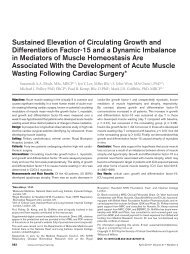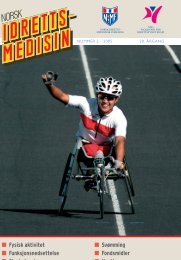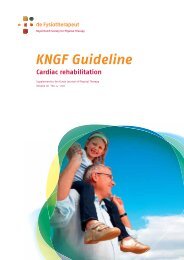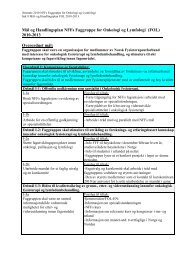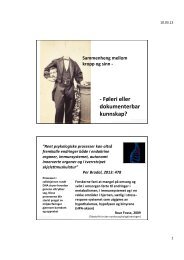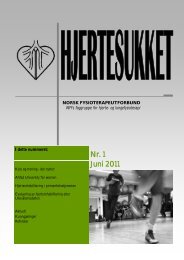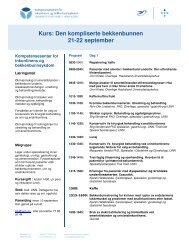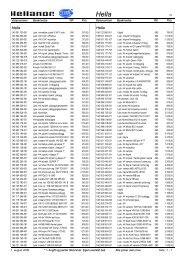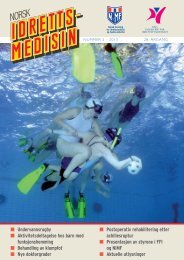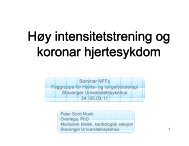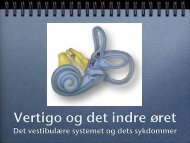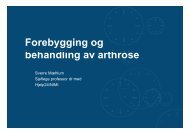GERIATRIX - 75 - Februar 2011.pdf - Norsk Fysioterapeutforbund
GERIATRIX - 75 - Februar 2011.pdf - Norsk Fysioterapeutforbund
GERIATRIX - 75 - Februar 2011.pdf - Norsk Fysioterapeutforbund
Create successful ePaper yourself
Turn your PDF publications into a flip-book with our unique Google optimized e-Paper software.
Activities of daily living. The ‘FIMa-m’ wasregistered as completed for 97.2 % of the residentswith a median score of 47 points and ‘FIMn-r’ wascompleted for 96 %, with a median score of 25points (Table 1).The COVS was completed by 90.7 % , with amedian score of 58 points (Table 1).Regarding physical activity the NHLSD: area wascompleted by <strong>75</strong>.8% (Table 1) with a median scoreof 24.0 points for the subscale that addresses extentdependence 74.2 % had scores and the value ofmedian was 36.0 points.IntercorrelationsTable 2 shows the correlation coefficients betweenthe residents’ scores of tests on muscle strength,balance, cognitive function, mobility, ADL andphysical activity. A high score on all themeasurements indicates better results, except forone measure (“the Timed Chair Stand”) where ahigh score indicates poor results, and therefore thecorrelations associated with the ‘Timed Chair Standtest’ show negative values. The results presented inTable 2 indicate significant correlations betweenmeasurements, ranging between 0.14 and 0.90.Nineteen comparisons have a correlation coefficientof 0.50 or larger.DISCUSSIONThe aim of this study was to investigate thefeasibility of measurements of muscle strength,balance, cognitive function, mobility, ADL andphysical activity when used in nursing homeresidents as well as the level of correlation betweenthem. Our baseline data show that elderly nursinghome residents in three Scandinavian countries area heterogeneous group. The data show that elderlynursing home residents differed greatly in theirperformance on the different tests. The variation inthe physical and cognitive abilities amonginstitutional residents has also been recognised byother authors (Lazowski et al., 1999; Kolanowski etal., 2006; Lindelöf et al., 2008). The fact that ourstudy group is heterogeneous indicates thatassessment of elderly persons should beindividually tailored. Little published data wasfound regarding the functional level of nursinghome residents in these three Scandinaviancountries. However, the Minimum Data Set (MDS)and national surveys have yielded considerableinformation about this population in the US whereZhang et al.,( 2009) reported clinical measurementsof nursing home residents by using Online SurveyCertification and Reporting measuring regardingmobility, mental status, skin integrity, need forspecial care and medication. The results in all themeasurement scales used cover the scale’s wholerange which could be one indicator of goodfeasibility for the measurements . We observed noceiling effect or floor effect, which could be anotherindicator of feasibility of the measurement. Ourresults show that the degree of functionaldependence is high for persons living in nursinghomes as shown by earlier study (Koroknay et al1996; Bentzen et al 2008; Lee et al 2009). Based onour results, measurements in further researchshould focus on the feasibility of instrumentssuitable for those with the lowest level offunctioning.Feasibility is in this study related also to how manyhave completed the tests. In general more than70% of the sample completed the tests. FIM wasthe test on which the highest number of individualsperformed. The high completion rate may be due tothe fact that it was based on staff evaluation. TheFIM is the most widely used measure of functionalstatus in rehabilitation patients in the United States(Thomas et al., 2007). The FIM contains moredomains and a wider score range than the COVS.An additional benefit of measuring functional statuslies in the ability to target interventions aimed atpreventing future decline. Identifying functionallyimpaired persons may lead to opportunities toimprove functional outcomes (Fiatrone et al.,1994). The nursing home population is becomingincreasingly functionally impaired (Thomas et al.,2007; Selbaek et al., 2007) and this seems to be auseful test for most of our participants.When the number of participants (n) is lower than258, means that 20% of the 322 participants havenot performed the test for some reasons. This couldindicate that the tests of these instruments are toodemanding to use for frail paricipants. It couldfurther indicate lack of willingness or availability ofthe participants or the staff to perform the tests,because in some case the measurements were basedon the staff evaluation). The ‘Timed Chair StandTest’ was only completed by 44.7 %, however, butthat can be explained by the fact that only 56.6 % ofthe residents could rise from a chair independently.Geriatrix nr. <strong>75</strong>, <strong>Februar</strong> 2011 - 10



